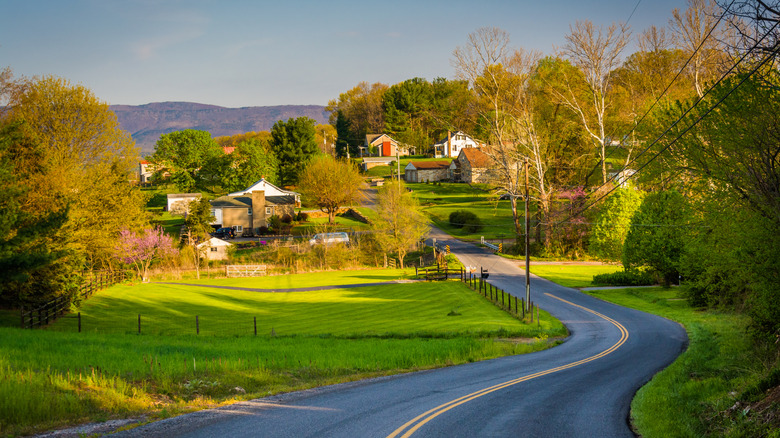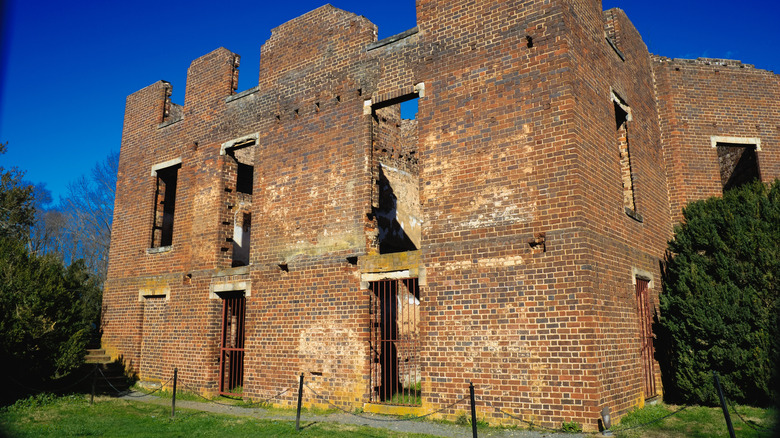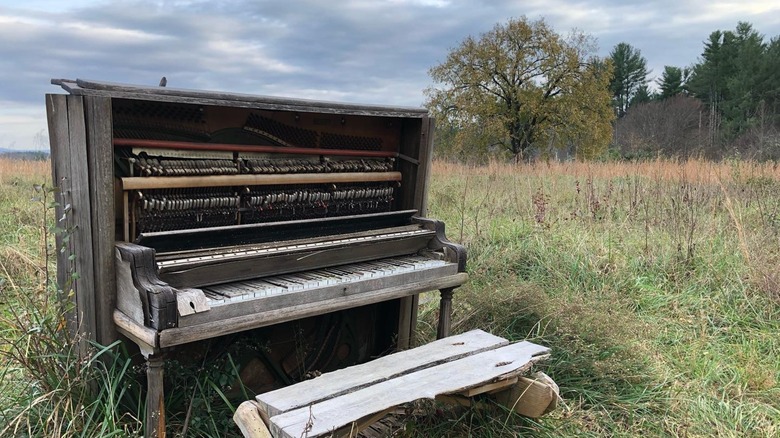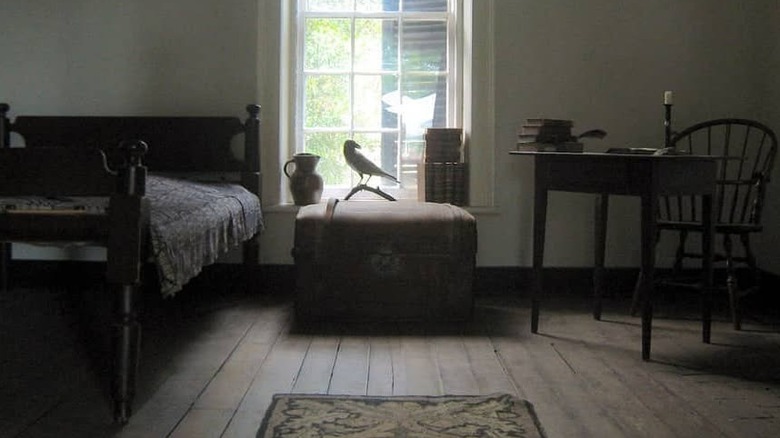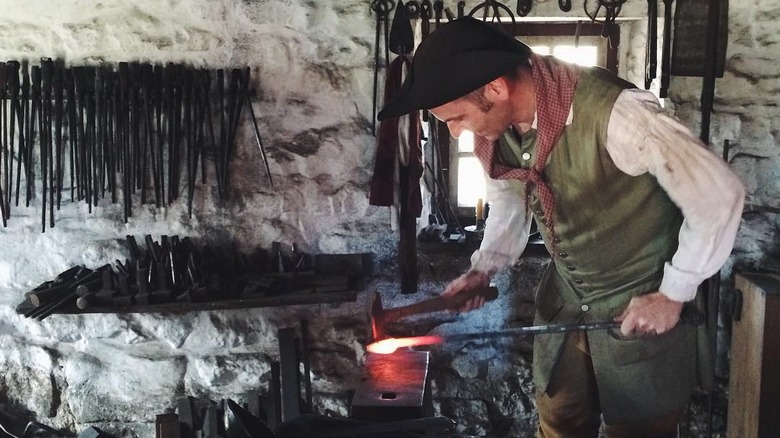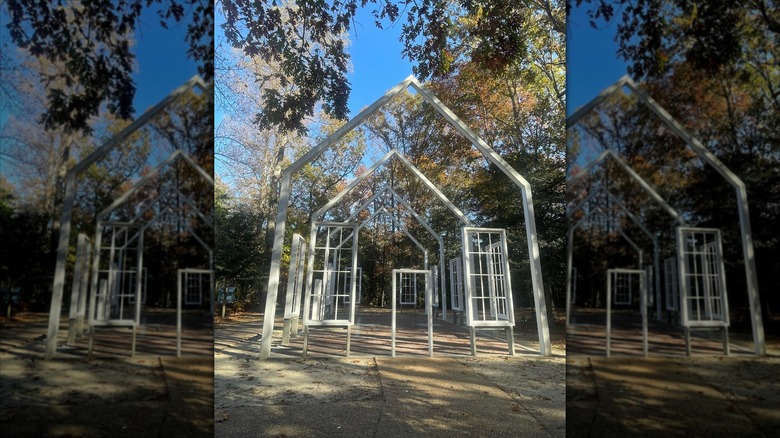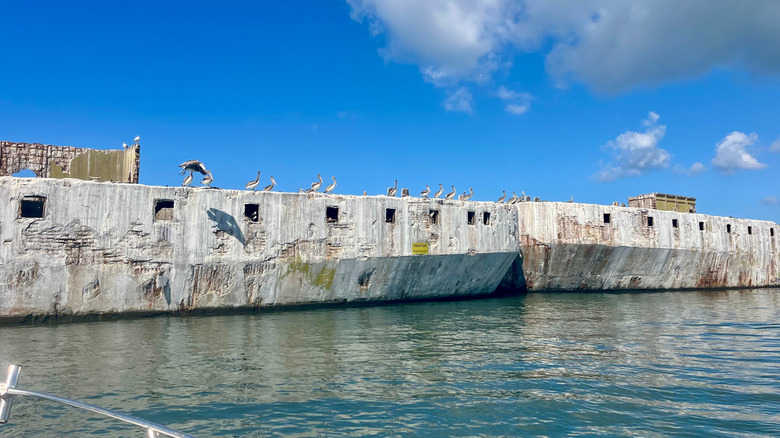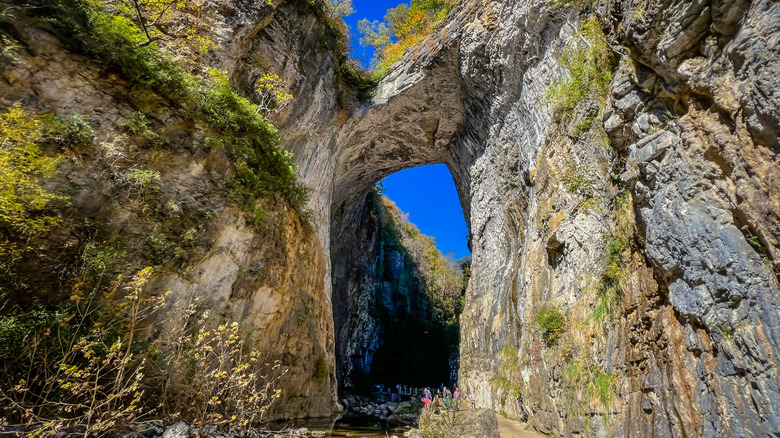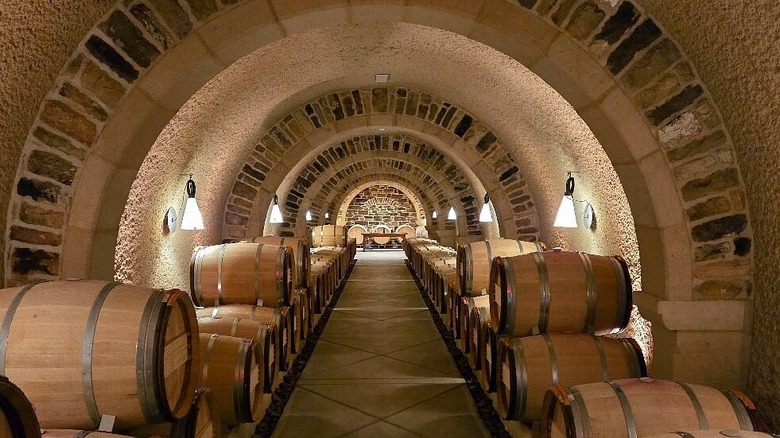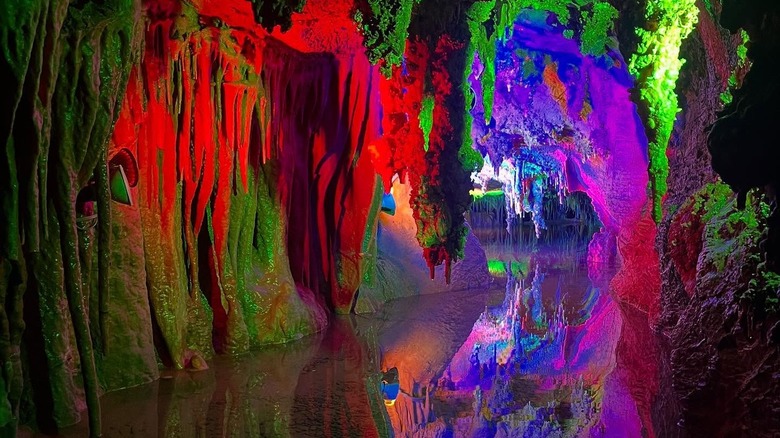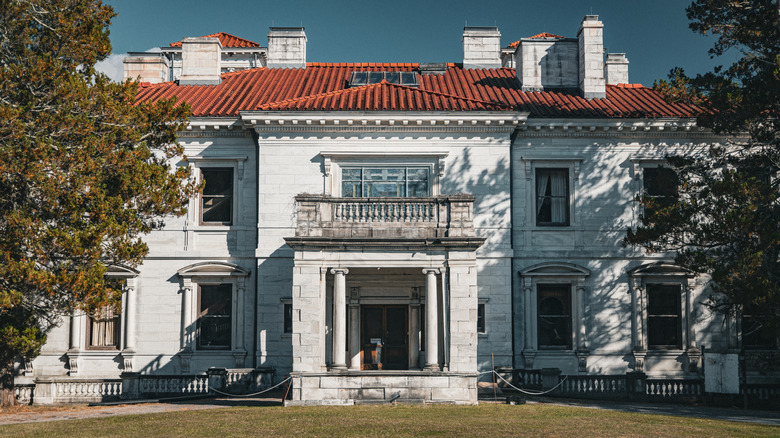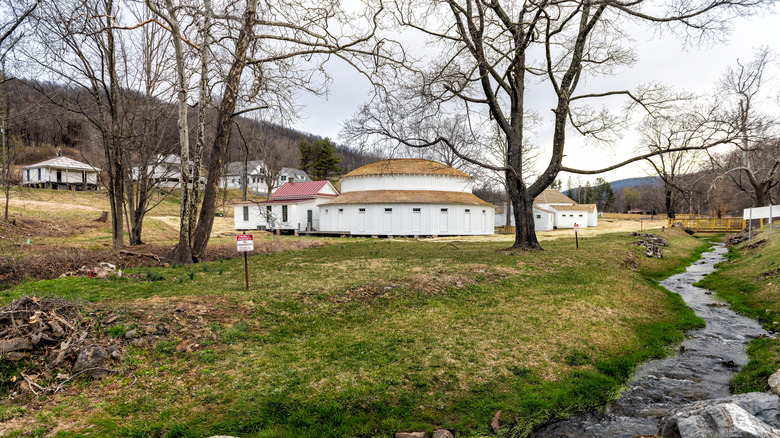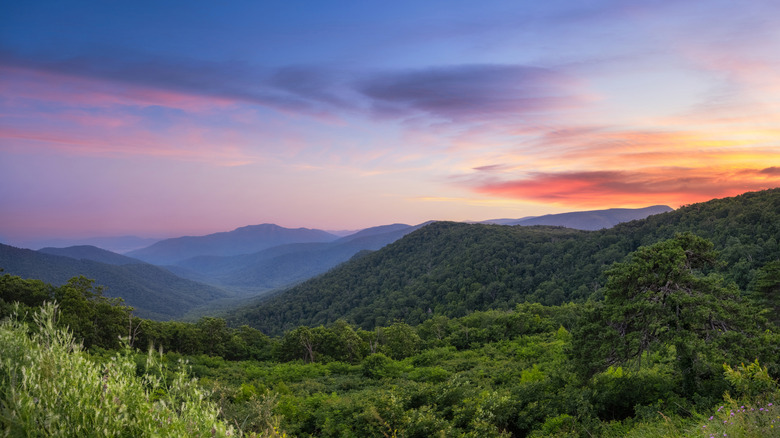The Most Underrated Destinations In All Of Virginia, According To Visitors
Virginia has its greatest hits when it comes to travel: spots like Colonial Williamsburg, Arlington National Cemetery, Virginia Beach, the Jamestown Settlement, and Chincoteague National Wildlife Refuge. However, there's a lot more to do in this state than meets the eye-tinerary. Tons of underrated attractions are hidden throughout Virginia's rolling hills, beautiful beaches, and even underneath its surface.
The following destinations usually don't make it to the top of Virginia's must-visit lists, but they should, as they're one-of-a-kind and jam-packed with eclectic history. They're also raved about by bloggers and the media. Past visitors love them too, since all of the places featured here have earned at least 4 stars on sites such as Google and Tripadvisor. Had enough of the long lines and crowds? Explore one of Virginia's hidden gems instead.
Barboursville Vineyards and Historic Ruins, Barboursville
On the grounds of a derelict estate designed by Thomas Jefferson sits Barboursville Vineyards, one of the oldest wineries in Virginia. The estate's mansion, owned by Jefferson's friend James Barbour, was built in the early 1800s . It caught fire in 1884, leaving behind brick walls and columns. Jefferson once hoped to establish a vineyard at his own Virginia home, and in full-circle circumstances, Barbour's property became a winery after the fire.
Barboursville Vineyards has a tasting room that pays homage to the estate's history called Library 1821. It features historic artifacts like a letter written by John Quincy Adams naming Barbour the Secretary of War. Perhaps the best way to get in the spirit of the previously grand home is by checking it out over a glass of wine. The ruins, now a National Historic Landmark, are open to the public (though you can't actually go inside).
"Walking around the historic ruins of the property, a home designed by Jefferson himself, is most interesting," a past visitor wrote of the experience on Tripadvisor. "A nice tasting room, an outside deck to enjoy the grounds and a wonderful restaurant all make this a special winery to visit." With over 600 reviews, Barboursville Vineyards & Ruins has earned 4.3 stars on the platform, making it a prime stop on a wine-centric road trip through Virginia.
Boxerwood Nature Center and Woodland Garden, Lexington
The Boxerwood Nature Center and Woodland Garden in Lexington not only showcases the beauty of Mother Nature, but utilizes it. The 15-acre environmental education center includes a natural burial ground called The Meadow that visitors can explore. If that seems a little grim to you, you can walk the property's trails and see its two ponds and plethora of plants and animals. Mourning doves, eastern painted turtles, red-bellied woodpeckers, blue jays, and northern cardinals all call the center home, among other creatures.
A haven for bird watching, Rockbridge Bird Club bird walks take place at Boxerwood every month. Other regular activities held at the center include summer evening concerts, an interactive jack-o-lantern display held each fall, and a winter craft series where attendees make home décor using natural materials. However, you'll find plenty of reasons to visit Boxerwood Nature Center and Woodland Garden even outside of special occasions, especially if you have children to entertain. It offers regular highlights like a fairy forest, a pollinator garden, a PlayTrail, and more.
"This place brought out so much excitement in two 33 year olds; it's not just for kids!" shared a reviewer on Google. "We were inspired by the whimsical and artistic nature of the whole place. We wandered for an hour or so and loved every bit of it." Boxerwood has earned 4.8 stars on the platform from 202 reviews.
Edgar Allan Poe Room, Charlottesville
Before Edgar Allen Poe became the father of macabre writing, he was just another University of Virginia student in a peaceful town tucked in the Shenandoah Valley. His one-year stint at the school lives on through his former dorm room at 13 West Range thanks to the work of the Raven Society, a group that has celebrated gifted professors and students for more than a century. Back in 1924 — more than 100 years after Poe attended the college — a professor and member of the society restored the room to how Poe would have remembered it.
These days, the society uses the room to initiate members by nightfall. Visitors can see it for themselves during the day via a glass wall. While they check out items like a stuffed raven, a desk, and a feather quill, they can listen to audio about the writer's short time as a student by pressing a button. Unfortunately, Poe didn't get to stay at the school longer than one year due to a lack of funds. He was reportedly so hard for cash that the reason that his original dorm furniture doesn't exist is because he burned it to keep warm.
Frontier Culture Museum, Staunton
Travelers can experience Virginia's history as one of the first British colonies in America at the Frontier Culture Museum, the largest open-air museum in the region. It's located in Staunton, one of the most underrated small towns in America. Everyone from kids to history buffs can see the lives of indigenous people, European settlers from the 1600s and 1700s, and enslaved Africans in real time. And with tons of interactivity, they can also meet blacksmiths, tailors, and yarn spinners. It's all accessible via self-guided and guided tours available nearly every day of the year. It's also worth multiple visits, as new elements are added all the time. Tickets are $12 per adult and $7 per child.
"This museum is a hidden gem, especially for families with younger children," an individual posted on Tripadvisor, where The Frontier Culture Museum has earned 4.7 stars from more than 700 reviews. "The living vignettes of the diverse cultures that settled in North America really made history come alive. The foodways presentation in the Native American section of the Old World exhibit was particularly illuminating. Well worth a visit for history lovers and families!"
Ghost Church, Mechanicsville
The fight for freedom was the crux of the Civil War. And although a skirmish took out a Mechanicsville church that represented religious freedom and universal education, it persevered — just like the Union did. Today, that building, then known as Polegreen Church, lives on through several white steel beams .
Dubbed the Ghost Church, the beams stand on the site of the mid-1700s place of worship where Samuel Davies fought for religious freedom and educating enslaved Africans. It was the first non-Anglican church in the state, as the Anglican church was the only one with official representation in the colony at the time. It burned down exactly a century later when it was hit by Confederate bullets. Due to financial hardship, it wasn't rebuilt, although the foundation was added to the National Register of Historic Places in 1991.
In 2007, an architect was commissioned to create the Ghost Church to pay homage to the original building's history. Since then, it's been a spot for weddings, lectures, and events. "A+ historical site," wrote a past visitor on Google, where the Ghost Church has 4.9 stars from over 50 reviews. "The ghostlike frame recreation of the church is brilliant, and there is much more. The role of this church is placed in local, national and international context with text and other displays. Whoever did this site really got it right."
Kiptopeke's Concrete Fleet, Cape Charles
A ghostly memorial of America's maritime history offers a peek into the past, along with a unique and creepy secret, at Virginia's Kiptopeke State Park in Cape Charles. Not far off the shoreline sit nine ships made from concrete at the request of the U.S. Maritime Commission during World War II due to the high price of steel. A total of 24 ships were constructed, used for everything from preparing for D-Day in Normandy to training in the South Pacific.
The nine concrete ships at Kiptopeke State Park were utilized for the protection of the former Chesapeake Bay ferry terminal starting in 1948. But when the Chesapeake Bay Bridge-Tunnel was finished in 1964, the terminal no longer served a purpose — and neither did the concrete ships. Today, visitors can view the 100-foot-long vessels, which shield the shore and provide a habitat to local fauna. "Wonderful beach, trails and the cement ships," a previous visitor shared on Tripadvisor, where Kiptopeke State Park has 4.4 stars from more than 300 reviews. "Bring a kayak if you can, we would have loved to paddle out to the ships that are set in place to protect the beach area from erosion."
The Natural Bridge
Virginia is full of natural wonders, but one is so beloved that both the town and state park it's in are named after it. In fact, Thomas Jefferson was so taken with the 200-foot-tall limestone gorge created by Cedar Creek that he arranged for ownership of the Natural Bridge in 1774. He spent nearly a week on horseback to reach it at times, but it was worth it to him — and his friends.
Former U.S. presidents and international celebrities visited the bridge after it became Jefferson's property. So did travelers from Europe, with many making the trip just to see the Natural Bridge. It was even a widely-used wallpaper design in France, called one of the natural wonders of the world, and made it on the National Register of Historic Places.
Besides the bridge, visitors to Natural Bridge State Park can check out forests, 10 miles of trails, a 50-foot waterfall, meadows, and mountain views. The location is also ideal for families, as it includes a kids' trail and outdoor classroom. "We went early in the morning. No more than 10 people there," wrote a past visitor on Tripadvisor, where the park has earned 4.3 stars from more than 2,100 reviews. "Super quiet and pretty. Worth a stop! ... Jefferson was a bright guy. This place was special."
RdV Vineyards, Delaplane
Virginia isn't Bordeaux, but RdV Vineyards certainly feels like it. This Delaplane winery in the Blue Ridge Mountains is no party-focused affair. It offers wines that go neck-and-neck with the best on the planet. Using grapes grown on 100 acres of land, RdV Vineyards makes Lost Mountain and Rendezvous wines . It serves them in a tasting room just as elegant. Inside the barn-like space, visitors will find themselves surrounded by a fireplace, cowhide, and leather furniture as they start their visit with Dom Pérignon. Wine tastings are accompanied by charcuterie boards with items like foie gras and a tour, for the price of $120 to $175 per person.
The luxe nature of RdV Vineyards is as founder and winery namesake Rutger de Vink intended when he produced his first vintage in 2010. The former marine and corporate executive's wine has earned accolades from wine afficionados like James Suckling and Robert Parker. "Incredible place, very good wine, and a nice tour," wrote a previous visitor on Tripadvisor, who named their review "Nice as Napa." "Will definitely return, and hope to get on their membership list. Ignore the naysayers, the price of admission is well worth it!" For more worthwhile wine destinations nearby, check out this under-the-radar wine region in Virginia after your visit.
Shenandoah Caverns
Places with names like Grotto of the Gods, Cathedral Hall, and Rainbow Lake sound like dreamy European destinations. But they're all found in one underrated Virginia attraction: the Shenandoah Caverns beneath Shenandoah Valley. Inside the only cavern in the state with an elevator, the "breakfast bacon" formations that were featured by National Geographic await, as well as flowstone, stalagmites, and stalactites. Visitors can also enjoy the gemstone mining sluice, where kids will love panning for gems in the water. Additionally, a retro café offers classic American fare and a soda fountain.
The caverns were discovered in 1884 by a farmer while the Southern Railway was being built, and opened to the public in 1922. The elevator followed later. The cave system, formed by subterranean rivers and the shifting of the earth's surface, were around for millions of years before that.
One-hour guided tours spanning about 1 mile of the space are available for $34 per adult and $16 per child — prices that many travelers have found worth paying. "The caverns are amazing! We've never experienced anything like it," wrote a previous visitor on Tripadvisor, where Shenandoah Caverns has garnered 4.5 stars from over 600 reviews. "The staff were all amazing and seemed very excited and interested in sharing the history of the caverns. Such a cool experience!"
Swannanoa villa, Afton
The 1912 construction of Swannanoa villa in Afton was inspired by the Villa de Medici in Rome. It's no wonder that it's one of the top historic mansions to visit in America. The villa is permeated with marble, including the Italian Carrara & Siena variety inside and white Georgia outside. James Dooley paid 300 workers $2 million to build it, which would be nearly $66 million today.
Swannanoa was a love letter for Dooley's wife, Sallie May. A 4,000-piece, 10-foot-tall Tiffany stained glass window at the top of a grand staircase even looks like her. Dooley, a Chesapeake and Ohio Railroad Company executive, died a decade after the mansion was built. Sallie May died three years after that. Swannanoa then became a country club before it was abandoned. Parts of it were rejuvenated in 1999.
Swannanoa villa can be toured, although it still has remnants of its abandonment. Tours are held seasonally by appointment only on the second weekend of each month for $36.25 per person. "This was such a beautiful place! We absolutely loved our visit!" wrote a past visitor on Google, where Swannanoa has garnered 4.6 stars on from more than 100 reviews. "The tour guides were so passionate & knowledgeable. Their love of the palace really shines through in the tour. The stained glass is worth the trip alone! It is truly stunning & photos do not do it justice!"
Warm Springs Pools, Hot Springs
The Omni Homestead Resort & Spa in the town of Hot Springs is a modern hotel. But just 5 miles away, it runs the historic Warm Springs Pools, natural crystal hot springs that have been used for nine millennia. They're even on the Virginia Landmarks Register and the National Register of Historic Places. For $35-$40 (depending on the day), visitors can sink into in these historic mineral waters that once made up the first spa in the country, dating back to 1761. Or, they can enjoy one of the spa's unique treatments, like sound baths that utilize gongs, chimes, and singing bowls.
No matter which service you opt for, you'll get to indulge in the pools' high mineral content, extreme clarity, 99-degree temperature, and 1,700,000-gallon-per-day flow. "The staff here is very friendly and the pools are amazing! It's really cool to think about the history of them also, while you're in there. We'll definitely be back!" wrote one past visitor on Tripadvisor, where the Warm Springs Pools have earned 4 stars from more than 300 reviews.
Methodology
To determine the most underrated things to do in Virginia, Explore combed through media reports and travel blogs to see which places were known as under-the-radar destinations. We whittled down our list by then determining which spots had elements that couldn't be found anywhere else, like a fleet of abandoned concrete ships and the bones of a church that pay homage to a courageous past. Then, we used sites like Tripadvisor and Google to see which options had the highest reviews, with at least 4 stars. The result? A lineup that those looking to go beyond a stereotypical bucket list will appreciate.
